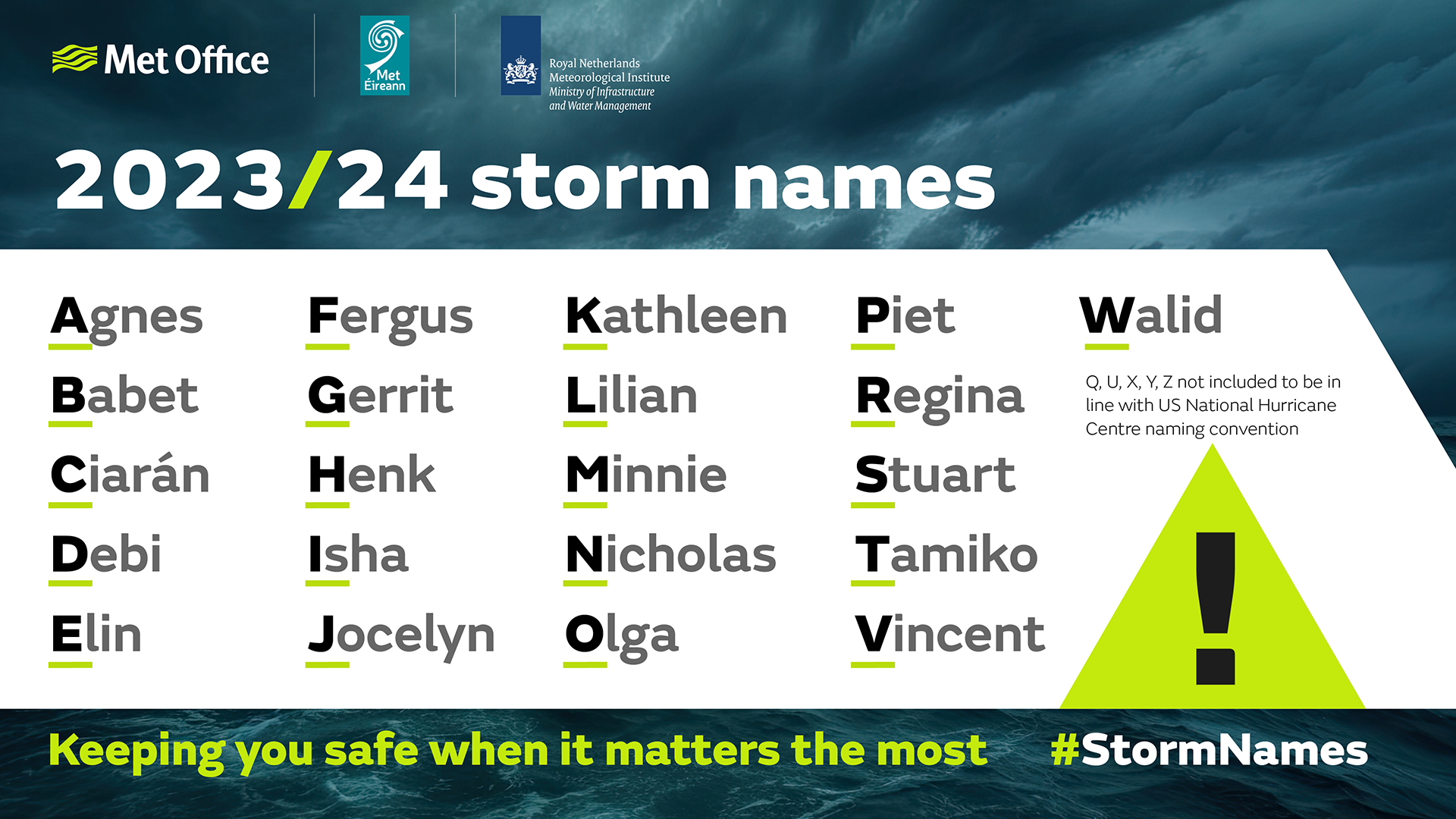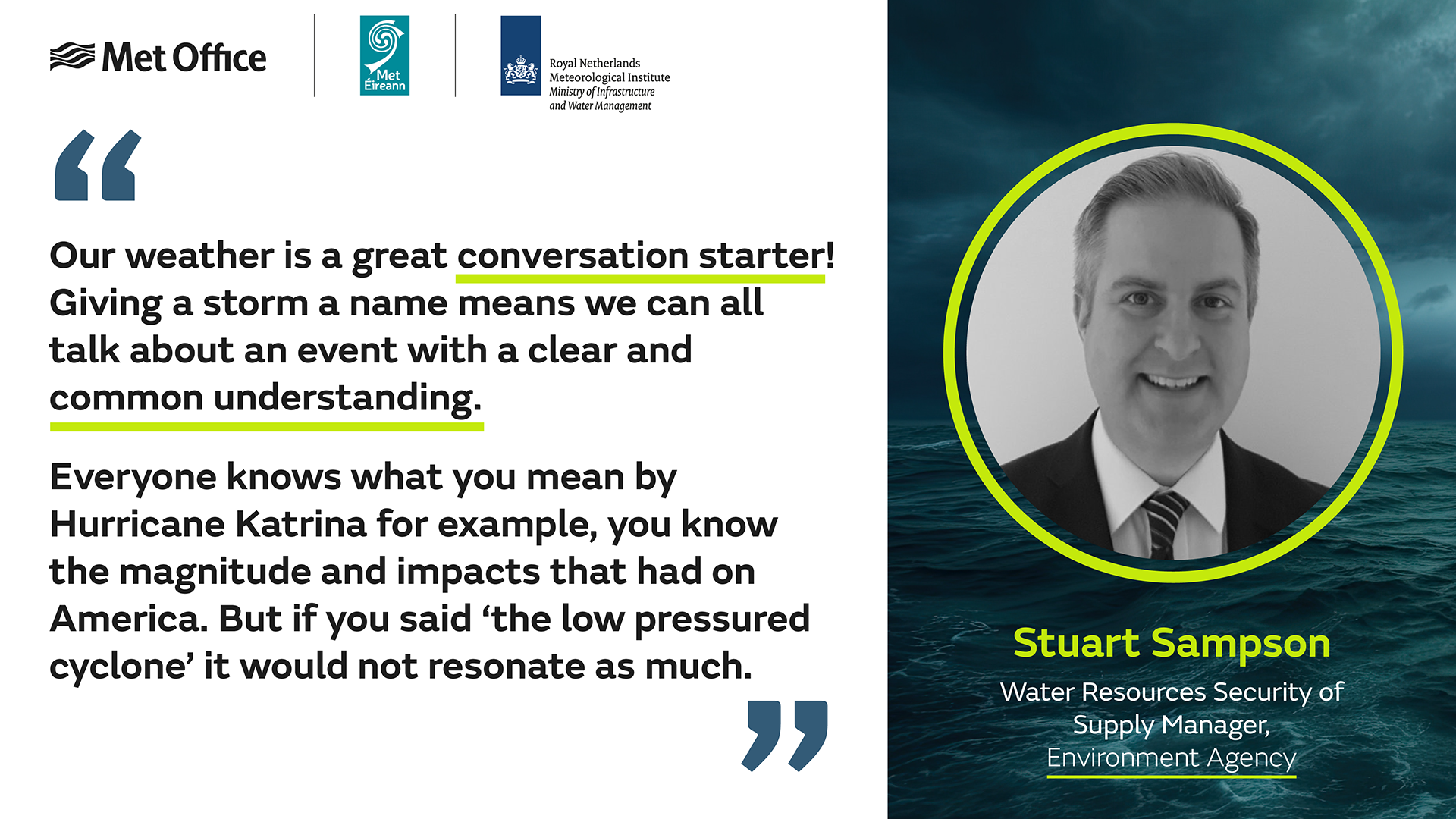Weather responders included in 2023/24 storm names
Author: Press Office
00:01 (UTC+1) on Fri 1 Sep 2023
The names of those who work to keep people safe in times of severe weather have been included in the new storm names for the 2023/24 season.
The Met Office, in partnership with Met Éireann and KNMI, have announced the new list of storm names for the 2023/24 season.
- Agnes, Babet and Ciarán will be the first three named storms by the group this season.
- Met Office contributions to the list include submissions from the public and names of those involved in responses to severe weather.
- Naming storms helps to communicate the risks of severe weather.
Storms will get named by the group when they’re deemed to have the potential to cause ‘medium’ or ‘high’ impacts in the UK, Ireland or the Netherlands. Wind is the primary consideration for naming a storm, but additional impacts from rain or snow will also be considered in the naming process.

The group named two storms in the 2022/23 season, with Storms Antoni and Betty impacting the UK and Ireland in August. However, as per international agreements, the group also adopted the names Otto and Noa which were named by other meteorological organisations in February and April respectively and had residual impacts on the UK.
Met Office Head of Situational Awareness Will Lang, who leads responses in times of severe weather, said: “This is the ninth year of us naming storms and we do it because it works. Naming storms helps to ease communication of severe weather and provides clarity when people could be impacted by the weather.
“This year, it’s great to be able to recognise the collaborative efforts of some of our partners across the UK with the inclusion of names from some partner organisations. Working across different agencies allows us to help as many people as possible be prepared for severe weather.”
A partnership approach
The Met Office, Met Eireann and KNMI collate the list together. This year, Met Office suggestions include names of people who work to protect the public in times of severe weather, as well as submissions from the public.
Ciarán was submitted by the public but is also the name of Ciarán Fearon, who works for the Department for Infrastructure in Northern Ireland. He uses Met Office forecasts on a regular basis and ensures relevant information is shared on river levels, coastal flooding and other impacts of severe weather.
He said: “With the effects of climate change, we are more aware than ever of how weather can affect us all in every aspect of our daily lives. In my role with the Department for Infrastructure I work closely with local communities in Northern Ireland and multi-agency partners to help keep everyone as warned and informed as possible.
“We need to respect each weather event and this work, particularly during periods of severe weather and storms, helps to ensure that we are all as well prepared as possible to help reduce the impact of such events.”
Debi Garft, who recently retired as Senior Policy Officer in the Scottish Government Flooding Team, shares a first name with the fourth name in the list. She also helped in the formation of both the Scottish Flood Forum and the Scottish Flood Forecasting Service.
Debi said: “It is important that we all take steps to protect ourselves, our family and property by preparing for extreme weather events. Checking the SEPA flood maps to see if your property or business is at flood risk, signing up for free SEPA Floodline local flood warnings and regional flood alerts, and using the daily Scottish Flood Forecast are great first steps.”
Met Éireann’s submissions are inspired by famous scientists, including Jocelyn after Dame Jocelyn Bell, the famous astrophysicist.
Names from KNMI are often of Dutch origin and many were submitted by public visitors to the forecaster throughout the year.
Natural Resources Wales’ Regina Simmons, who is a Team Leader for Warning and Informing, also finds her first name in the list. Her team uses Met Office data and forecasts to predict and warn for river and coastal flooding in Wales.
Regina said: “So many people think that flooding won’t happen to them. The first thing we can all do is check if our area is at risk of flooding before the rain starts to fall. People in Wales can do that by simply popping in their postcode on the online flood risk checker on the NRW website or by calling Floodline on 0345 988 1188.”
Stuart Sampson is the Environment Agency’s Water Resources Security of Supply Manager and has helped manage water supplies through a series of droughts over nearly 20 years.

Stuart said: “Our weather is a great conversation starter! Giving a storm a name means we can all talk about an event with a clear and common understanding. Everyone knows what you mean by Hurricane Katrina for example, you know the magnitude and impacts that had on America. But if you said ‘the low pressured cyclone’ it would not resonate as much. By naming storms, this will help everyone be better prepared and in the conversation.”
Fans of Beano might note that Storm Minnie is also included in the list, following in the footsteps of Storm Dennis in 2020. Minnie’s reaction is expected to feature in a Beano issue later in September, as part of a special feature on storms.
This year is the first time the list has broken with the traditional male/female ordering of names, in order to allow the inclusion of some of the more popular submitted names.
Why do storms get named?
Storms are named to aid communication when severe weather is in the forecast. This can help everyone to keep themselves, their property and businesses safe and protected at times of severe weather.
For Storm Eunice, which impacted the UK in 2022, 99% of people within the red warning area in the southeast were aware of the warnings, highlighting how effective storm naming is as a communications tool.
Sometimes, as happened earlier this year, storms are named by different national meteorological services. When this occurs, the Met Office, Met Eireann and KNMI will adopt the given name, as happened with Storms Otto (16 February) and Noa (12 April) in 2023.
Find out more on the UK Storm Centre.
2023/24 storm name list in full
Agnes
Babet
Ciarán
Debi
Elin
Fergus
Gerrit
Henk
Isha
Jocelyn
Kathleen
Lilian
Minnie
Nicholas
Olga
Piet
Regina
Stuart
Tamiko
Vincent
Walid





